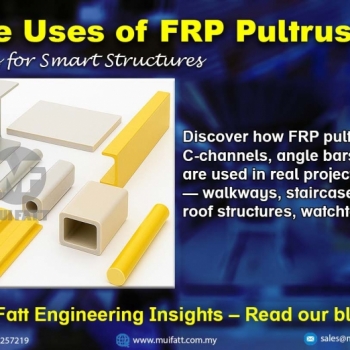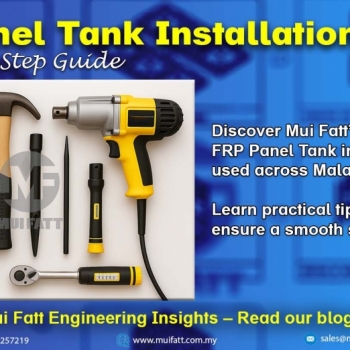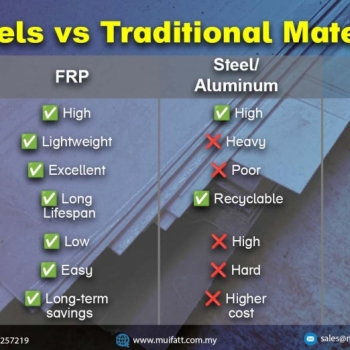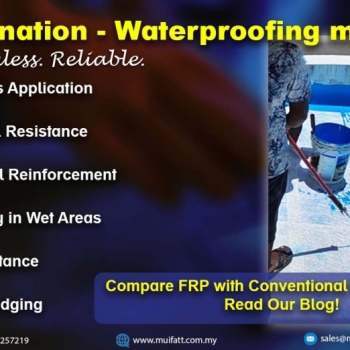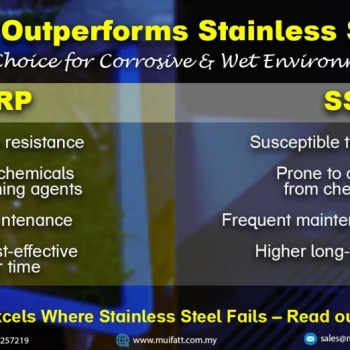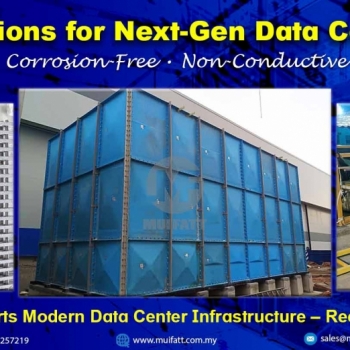FRP pultruded profiles are reshaping structural possibilities across Malaysia. From STP staircases to public park shelters, explore how these modular components enable custom FRP solutions—only from Mui Fatt.
Exploring Fiberglass as a Superior Alternative to Steel in Malaysia: Pros and Cons
29 Feb 2024
Fiberglass vs. Steel: A Comparative Analysis for Malaysia's Industries
Fiberglass vs. Steel: A Comparative Analysis for Malaysia's Industries
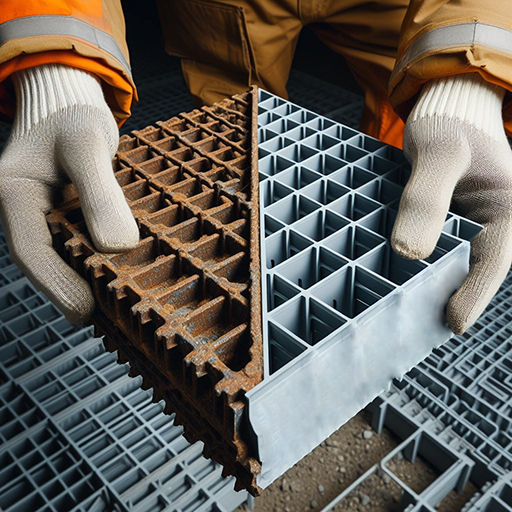
- Fiberglass Pros and Cons
- Pros of fiberglass in Malaysian Context
- Cons of fiberglass in Malaysian Context
- Pros and Cons of Steel
- Pros of Steel in Malaysia
- Cons of Steel in Malaysia
- Analyzing the Features of Fiberglass and Steel in Malaysia: A Side-by-Side Comparison
- Closing Thoughts
- Frequently Asked Questions
In Malaysia's dynamic construction scene, a pivotal discussion is underway: Fiberglass versus Steel.
With the nation's climate posing formidable challenges, discerning the strengths and weaknesses of these materials is paramount for making informed choices. Join us as we navigate through the intricacies of this debate, exploring how fiberglass, a plastic material, stands as a compelling substitute to steel with its durability and high tensile strength. We'll unravel its advantages and limitations across diverse applications, shedding light on its suitability amidst Malaysia's demanding environmental conditions.
Fiberglass Pros and Cons
| Features | Pros of fiberglass | Cons of fiberglass |
|---|---|---|
| Corrosion Resistance | - Resilient to corrosion in humid environments | - Higher upfront costs compared to steel |
| Lightweight Advantage | - Reduces labor expenses and logistical challenges | - Strength limitations for high tensile applications |
| Durability Under Pressure | - Withstands harsh weather and chemical exposure | - UV degradation concerns requiring maintenance |
| Versatility in Design | - Facilitates complex structure realization | - May not offer the same level of fire resistance as steel |
| Insulation Properties | - Enhances safety and efficiency in various applications | - Initial cost considerations for financial planning |
Pros of fiberglass in Malaysian Context
Corrosion Resistance:
Fiberglass's resilience to corrosion stands out in Malaysia's humid and corrosive environments, offering longevity and reliability unmatched by steel.
Lightweight Advantage:
In a country where transportation and installation costs matter, fiberglass's lightweight nature proves advantageous, reducing labor expenses and logistical challenges.
Durability Under Pressure:
Withstanding harsh weather conditions and chemical exposure, fiberglass, a plastic material reinforced with resin, boasts durability akin to steel, ensuring structural integrity over time in Malaysia's demanding settings.
Versatility in Design:
Fiberglass's flexibility in design and fabrication facilitates the realization of complex structures, overcoming limitations posed by steel and enabling innovative solutions.
Insulation Properties:
The exceptional thermal and electrical insulation properties of fiberglass enhance safety and efficiency in diverse applications, addressing specific needs in Malaysia's industries.
Cons of fiberglass in Malaysian Context
Initial Cost Considerations:
While fiberglass offers long-term savings, its higher upfront costs compared to steel may deter initial investment, necessitating careful financial planning.
Strength Limitations:
Certain applications requiring high tensile or compressive strength may pose challenges for fiberglass, where steel might still hold an advantage.
UV Degradation Concerns: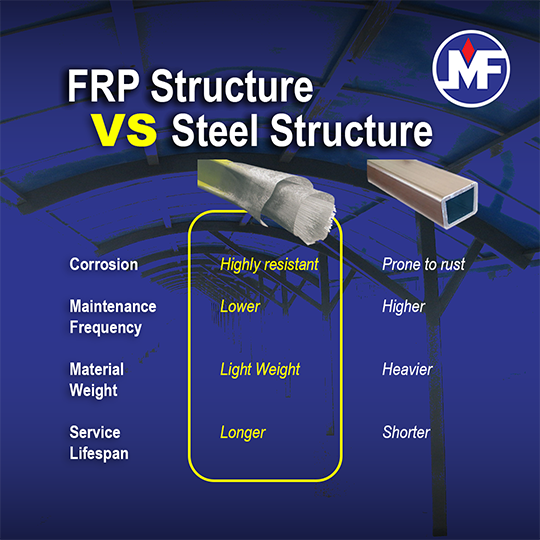
Exposure to UV radiation over time can compromise fiberglass's integrity, signaling the need for appropriate protective measures and maintenance protocols. However, protective coatings or barriers can be applied to overcome this problem.
Fire Resistance Evaluation:
Although inherently flame-retardant, fiberglass may not offer the same level of fire resistance as steel, prompting considerations in fire-prone environments.
When considering the use of fiberglass in Malaysia, several advantages and disadvantages come into play. Fiberglass stands out for its corrosion resistance in humid environments, lightweight nature reducing installation costs, and durability akin to steel. However, initial costs, strength limitations for certain applications, UV degradation concerns, and potential fire resistance issues must be carefully evaluated. To decide if fiberglass is a good fit for certain projects in Malaysia, it's important to consider both the advantages and disadvantages.
Pros and Cons of Steel
| Features | Pros | Cons |
|---|---|---|
| Strength | - High tensile strength | - Susceptible to corrosion |
| Durability | - Long lifespan | - Heavy and difficult to transport |
| Fire Resistance | - Excellent fire resistance | - May weaken under high temperatures |
| Sustainability | - Recyclable material | - Energy-intensive production process |
Pros of Steel in Malaysia
High Tensile Strength
Steel is known for its high tensile strength, providing exceptional durability and stability in construction projects.
Longevity and Durability
The durability of steel ensures a long lifespan for structures, minimizing maintenance needs and offering lasting value.
Fire Resistance
Steel offers excellent fire resistance, making it an essential choice for buildings in fire-prone areas, enhancing safety measures.
Structural Support
With its robust strength, steel is ideal for supporting heavy loads in buildings and infrastructure, ensuring structural integrity.
Cost-Effectiveness
The enduring durability of steel structures translates to lower maintenance costs over time, contributing to economic viability.
Safety Benefits
Steel's fire resistance properties provide added safety assurance, protecting occupants and assets in fire incidents.
Cons of Steel in Malaysia
Environmental Impact
Despite its recyclability, steel production is energy-intensive, posing challenges to sustainability efforts.
Vulnerability to Corrosion
Steel is susceptible to corrosion, requiring protective coatings to prevent rust and maintain structural integrity.
Logistical Challenges
The weight of steel can make transportation and installation challenging compared to lighter materials, requiring specialized equipment and careful planning.
Steel is a strong and long-lasting material that many people like to use for different things because it can withstand fire. But, we should remember that steel can get rusty and making it takes a lot of energy, so think about these things before choosing steel for building stuff.
Analyzing the Features of Fiberglass and Steel in Malaysia: A Side-by-Side Comparison
| Features | Pros of Fiberglass in Malaysia | Cons of Fiberglass in Malaysia | Pros of Steel | Cons of Steel |
|---|---|---|---|---|
| Corrosion Resistance | - Resilient to corrosion in humid environments | - Higher upfront costs compared to steel | - High tensile strength | - Susceptible to corrosion |
| Lightweight Advantage | - Reduces labor expenses and logistical challenges | - Strength limitations for high tensile applications | - Long lifespan | - Heavy and difficult to transport |
| Durability Under Pressure | - Withstands harsh weather and chemical exposure | - UV degradation concerns requiring maintenance | - Excellent fire resistance | - May weaken under high temperatures |
| Versatility in Design | - Facilitates complex structure realization | - May not offer the same level of fire resistance as steel | - Recyclable material | - Energy-intensive production process |
| Insulation Properties | - Enhances safety and efficiency in various applications | - Initial cost considerations for financial planning | - | - |
Closing Thoughts
Fiberglass emerges as a compelling alternative to steel in Malaysia's industrial landscape, boasting superior corrosion resistance, durability, and versatility. Despite some drawbacks, its numerous advantages position it as a pivotal player in the nation's pursuit of sustainable and innovative construction solutions.
Talk to us for your project today! WhatsApp or email – sales@muifatt.com.my . We guarantee our expertise to you.
Frequently Asked Questions
Is fiberglass a durable material compared to steel?
Fiberglass is known for its exceptional durability, surpassing steel in terms of corrosion resistance and longevity. Its ability to withstand harsh environmental conditions makes it a reliable choice for various industrial applications.
Can fiberglass be customized to fit specific project requirements?
Yes, fiberglass offers a high level of versatility and can be easily customized to meet specific project requirements. From shape and size to color and finish, fiberglass can be tailored to suit the needs of any construction project.
How does the cost of fiberglass compare to steel?
While the initial cost of fiberglass may be slightly higher than steel, its long-term durability and low maintenance requirements make it a cost-effective investment in the long run. The savings on maintenance and replacement costs outweigh the initial price difference.
Is fiberglass environmentally friendly compared to steel?
Fiberglass is considered a more environmentally friendly option compared to steel, as it is non-toxic, non-corrosive, and recyclable. Its sustainable properties make it an attractive choice for eco-conscious construction projects.
What are the drawbacks of using fiberglass instead of steel?
One potential drawback of fiberglass is its lower strength-to-weight ratio compared to steel. However, advancements in fiberglass technology have led to the development of high-strength fiberglass materials that can rival the strength of steel in certain applications.
Disclaimer:-
The information provided on this website is for general informational purposes only and does not constitute legal advice. While we strive to ensure the accuracy and reliability of the information provided, we make no representations or warranties of any kind, express or implied, about the completeness, accuracy, reliability, suitability, or availability concerning the information contained herein. Any reliance you place on such information is therefore strictly at your own risk. This website may contain links to other third-party websites. Such links are only for the convenience of the reader, user, or browser; which we do not warrant, recommend, endorse, or assume liability for the contents of the third-party sites.
Keep in touch with us should you be keen on receiving timely updates from us
- Website - https://www.muifatt.com.my/home/
- Facebook - https://www.facebook.com/muifattmarketing
- Instagram - https://www.instagram.com/muifattmarketing/
- Google - https://goo.gl/maps/WxVY13gNcaRTS7Jp6
- Youtube - http://www.youtube.com/@MuiFattMarketing
- TikTok - https://www.tiktok.com/@muifattmarketing
- LinkedIn - https://www.linkedin.com/company/mui-fatt-marketing-sdn-bhd-
- Linktree - https://linktr.ee/muifattmarketing
- Shopee - https://www.shopee.com.my/muifattmarketing
- Lazada - https://www.lazada.com.my/shop/mui-fatt-marketing
Recent Blog
Mui Fatt Engineering Insights - FRP Panel Tank Installation
Get to know the step-by-step assembly process of FRP sectional panel tanks, based on Mui Fatt’s industry-proven practices. This easy-to-digest guide is ideal for project managers, contractors, and technical personnel involved in water storage tank installation across Malaysia.
FRP Panels vs Traditional Alternatives: The Ultimate Guide to Durability and Sustainability
Explore why FRP (Fiberglass-Reinforced Plastic) panels outperform traditional materials like steel, plywood, and PVC in durability, sustainability, and cost-effectiveness. Discover real-world applications in MyKiosk projects and cold truck panel assembly, where FRP’s superior insulation, corrosion resistance, and lightweight properties deliver long-term benefits.
Comparing FRP Waterproofing with Traditional Systems
Is FRP lamination a better waterproofing method than traditional systems? Explore this complete guide with real project examples and see why FRP is gaining traction across Malaysia.
Benefits of FRP in Food Handling & Processing
With hygiene, durability, and corrosion resistance at its core, FRP (Fibreglass Reinforced Plastic) is becoming a preferred material in the food industry. This article explores why FRP is ideal for food handling equipment such as supermarket fish trays, water tanks, and food factory platforms, plus how Mui Fatt is delivering proven solutions through its successful FRP applications.
Mui Fatt Insights: Advanced Materials for Modern Needs
Is stainless steel the best for wet areas? This article explains why more industries are switching to FRP for its corrosion resistance, hygiene benefits, and longevity, especially in food displays and chemical exposure zones.
How FRP Supports Modern Data Center Infrastructure
Discover how fiberglass-reinforced plastic (FRP) is reshaping data center construction. Learn its key advantages, comparisons with other materials, and where to apply FRP—from rooftop chillers to cooling tanks.
Understanding FRP Filament Winding: Process, Benefits & Comparison
This article explores the FRP filament winding manufacturing method, how it differs from other FRP techniques, why it’s still widely used, and its long-term value for projects like high-strength tanks and cylinders.
